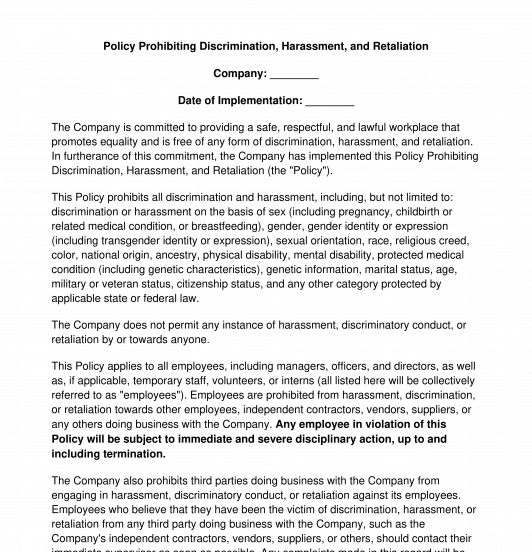 12/31/2024
12/31/2024

Answer a few questions and your document is created automatically.

Your document is ready! You will receive it in Word and PDF formats. You will be able to modify it.

 12/31/2024
12/31/2024
 Word and PDF
Word and PDF
 3 to 5 pages
3 to 5 pages



A Policy Prohibiting Discrimination, Harassment, and Retaliation is a document used by employers to outline their specific policy on prohibited conduct in the workplace. This is an extremely important policy document for any employer these days. Over the past several years, there have been more and more cases of employment-based discrimination, harassment, or retaliation and employers are increasingly becoming aware of the need for a comprehensive policy that will protect their employees.
Although these types of policies can be quite boilerplate, in that they do not vary much from organization to organization, this is because state laws on what constitutes discrimination, harassment, and retaliation are often very similar. The situations that constitute this type of prohibited conduct are not unique to any organization - all employers must protect their employees from this type of unlawful conduct.
Sometimes, a policy like this can be included in another employment document, such as an Employee Handbook. However, it is usually a good idea to have this be a standalone policy document, so that it can be far more comprehensive than something included in a handbook or other employment agreement.
This Policy Prohibiting Discrimination, Harassment, and Retaliation will cover all common situations that should be addressed by an employer.
How to use this document
This document is quite simple. It will only request readily-available information, such as company identifying information and a few other basic questions on the company's internal policy. The rest of the document will be filled out. As mentioned above, the reason more information is not requested is because these documents tend to be the same between organizations and variance isn't needed. In fact, variance usually is not a good idea, as common prohibited conduct situations may be missed.
When this policy document is filled out, it should be disseminated to employees, but it is a good idea to check with a licensed attorney in your state regarding specific notice requirements.
Applicable law
Several states have specific requirements for these types of policies, as listed below. Others only require these policies in certain sectors or only make recommendations regarding these policies. However, many states also have additional requirements, such as displays needed for anti-harassment posters, specific notice requirements for the policy, or employee training. It is a good idea to discuss these issues with a licensed attorney.
California - Cal. Gov't Code § 12940(k)
Connecticut - Connecticut Public Act No. 19-16
Maine - Me. Stat. tit. 26, § 807(2)
Massachusetts - Mass. Gen. Laws ch. 151B, § 3A(b)
New York - N.Y. Lab. Law § 201-g
Rhode Island - R.I. Gen. Laws § 28-51-2
Vermont - Vt. Stat. Ann. tit. 21, § 495h(b), (c)
How to modify the template
You fill out a form. The document is created before your eyes as you respond to the questions.
At the end, you receive it in Word and PDF formats. You can modify it and reuse it.
Country: United States